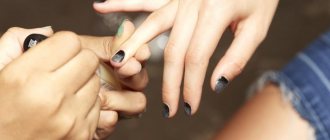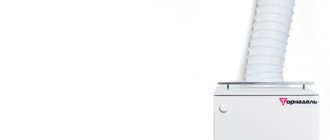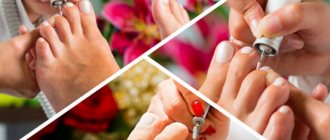Progress does not stand still, penetrating into all areas of life, including those related to beauty and health. Therefore, it is not surprising that today the classic pedicure has been replaced by a hardware pedicure - a more effective, comfortable and safe procedure.
We will talk about the distinctive features of hardware pedicure, its types, advantages and disadvantages in this article. At the same time, we will provide step-by-step instructions for processing legs using this device.
- 2 Features of hardware pedicure
- 3 What problems can a hardware pedicure solve?
- 4 Advantages of hardware pedicure
- 5 Disadvantages of hardware pedicure
- 6 Technology for performing hardware pedicure at home
- 7 How to choose a hardware pedicure specialist
What is a hardware pedicure
Pedicure is a comprehensive care for the heels, feet, toes and nail plates. Previously, such a procedure was considered exclusively cosmetic and was the absolute privilege of women. However, times have changed, and today most people do pedicures, regardless of gender and age, because this procedure, aimed at maintaining healthy feet, helps prevent many foot problems.
But what’s even more interesting is that new technology for caring for nails and feet has also contributed to the popularization of pedicure. Its homeland is Germany, where for the first time they began to use a special cosmetology device with cutter attachments for foot care. It turned out that due to the rapid rotation of specially selected attachments, it is much easier to remove keratinized epithelium, heel calluses and cracks. Moreover, with suitable attachments it has become more convenient to remove cuticles, polish nails and shape the nail bed.
Execution technique
Hardware pedicure (what it is is described above), as we have already written, is done without first soaking the feet. But it is still necessary to soften the skin, and for this purpose special solutions are used that are endowed with keratolytic properties. They only affect dead cells and do not touch healthy ones, so there is no need to worry about their safety.
First of all, the client is seated in a comfortable pedicure chair, the skin is softened, and then they begin to polish it using a device with various attachments. The pedicure set has all the necessary cutters to remove corns and rough skin between the toes and on their tips. Attachments with different diameters and abrasiveness, as well as the presence of several speeds, allow the master to work, taking into account all the individual characteristics of the client’s skin, to grind the relief more smoothly and efficiently.
What problems, other than corns, can be dealt with using a hardware pedicure?
Features of hardware pedicure
Currently, pedicure equipment is available in every beauty salon, and if you really want, you can purchase such equipment for personal use in order to independently maintain the normal condition of your feet. This technique is inexpensive, but its benefits are simply enormous.
Interestingly, unlike a classic pedicure, which required preliminary steaming of the feet, a hardware pedicure is carried out without steaming. And this is not only a significant time saving, but also good news for “diabetics” and people with circulatory problems, that is, for all those for whom steaming their legs is contraindicated.
Instead of hot water, special softeners are used to soften the skin and expand pores. Such creams and gels perfectly soften calluses, corns and rough skin between the fingers, which can then be easily removed with a properly selected attachment.
Important! Softening foot creams and cuticle gels act exclusively on dead skin. Healthy cells are not damaged!
The pedicure machine can be equipped with both disposable and reusable cutters. They differ in the degree of abrasiveness, as well as in the type of material used. For example:
Diamond cutters. Used to remove corns and rough skin;
Ceramic cutters. Used to treat heel cracks;
Silicon lipid cutters. They are used quite rarely, if necessary, remove too rough and dry epithelium;
Silicone cutters. Women adore them, because these attachments can perfectly polish the nail plates.
Milling cutters
The classic set of an experienced master for performing a hardware pedicure should contain 4 main cutters: a cone, a ball, a needle, grinders and polishers for feet of various levels of hardness.
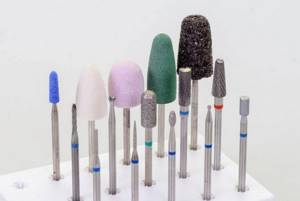
The rigidity of the cutter is determined by the cut. Three colors are suitable for pedicure – green, blue and red. Cutters with green notches and diamond coating are for rough skin, cutters with blue ones are the most popular for working with the skin of the cuticle, sinuses and sinuses of the nail, with red ones for working with the skin and sometimes the nail plate. They are considered soft. The yellow notch indicates the softest cutters with which you can safely work on natural nails.
What problems can a hardware pedicure solve?
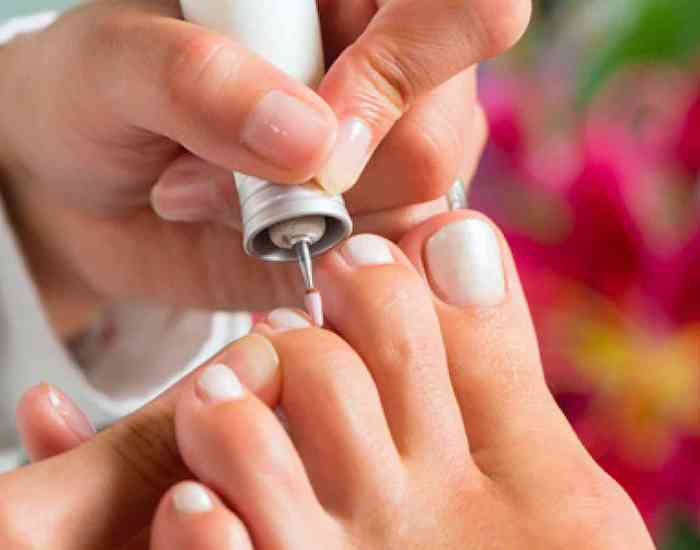
It must be said that using a special device for caring for the skin of the feet is much more effective than a classic pedicure, as it allows you to solve many problems with the nails and skin of the feet. Here are some of them:
- Cracked heels. Before starting the procedure, the sharp edges of the crack are cut off, and then the defect is sanded off using a cutter and a special attachment. Upon completion of the treatment, a special ointment is applied to the skin to help heal the crack.
- Ingrown nail. A device for caring for nail plates allows you to painlessly solve this problem. Before starting to eliminate the defect, a special softening gel is applied to the nail. This allows you to thin the sharp edges of the nail with a cutter, and painlessly remove the ingrown nail using tweezers. All that remains is to give the nail the correct shape to prevent re-ingrowing, and lubricate the damaged skin with gel for speedy healing.
- Calluses and corns. By analogy with previous procedures, the roughened area of skin is treated with a softening gel, after which the existing callus is removed using a milling cutter with a coarse nozzle.
- Cuticles. Using diamond or ceramic abrasives, the skin around the nail plate is easily processed and, above all, overgrown cuticles are removed. It is only important to first soften the cuticles so that removal is absolutely painless.
Important! The pedicure machine is an ideal tool for painless removal of hangnails.
- Onychomycosis. To eliminate a fungal infection of the nail, you have to constantly remove the affected part of the nail plate. A pedicure machine does an excellent job of this function.
- Plantar warts. By softening and sanding off the warts that appear on the sole, you can literally eliminate this extremely unpleasant problem in just a few procedures. Naturally, if you simultaneously take antiviral drugs aimed at eliminating the human papillomavirus (HPV).
- Thickening of the nail plate. In normal condition, the thickness of the nail does not exceed 1 mm. However, as a result of psoriasis or eczema, the plate can thicken, disfiguring beautiful nails. The problem can be solved surgically, but it is much easier and more painless to polish the nails using a hardware pedicure.
- Damage to the nail. Any damaged nail can be filed, smoothed and polished using a foot and nail care machine.

Types of hardware manicure
Depending on the manipulations performed, hardware pedicure is divided into three types:
Traditional. Mills are used to process feet, cuticles and polish nails;
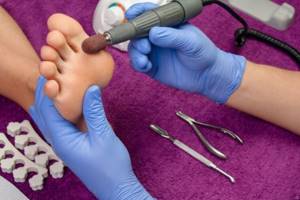
Unedged. In this case, the feet are treated with cutters, and the cuticle is not cut off, but treated with a remover and pushed back with a pusher. This procedure takes less time and requires less skill, but the cuticle heals within a couple of weeks;
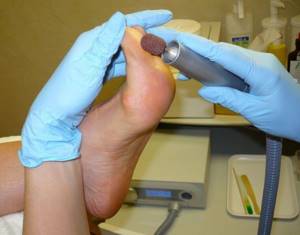
Spa pedicure. In addition to traditional procedures, it includes relaxing baths, scrubbing and massage.

It is important to remember that with a classic hardware pedicure, the feet do not need to be soaked too much; on the contrary, too soft skin will be less easily removed by the attachment. If you decide to have a spa pedicure, after the bath your feet should dry sufficiently before you can start treating them.

Advantages of hardware pedicure
To have an idea about the treatment in question, let's study its advantages over a classic pedicure.
- Safety. The device, developed with German meticulousness, allows you to delicately treat nails and feet, reaching the most inaccessible places. Unlike cosmetic scissors, files and curettes for pedicures, cutters with special attachments reduce the likelihood of cuts, and therefore minimize the risk of contracting infectious diseases.
- Painless. The vast majority of users call painlessness the main advantage of hardware pedicure. Indeed, when exposed to cutters, only light touches are felt, similar to a massage.
- Sterility. Before starting the procedure, the master puts on sterile gloves and uses disposable attachments, opening the packaging in front of the client. Reusable cutters must be treated with antiseptic agents. All this reduces the risk of infection to zero.
- Sustainable results. A distinctive feature of hardware pedicure is that when treating the skin on the feet, only dead skin particles are removed, and healthy cells are not damaged. In this case, the regeneration process does not start, and the skin grows more slowly, maintaining the achieved result longer.
- Lack of water. This foot treatment technology involves avoiding steaming your feet. Instead, various keratolytic creams, ointments and lotions are applied to the skin, which perfectly soften the dermis.
- Save time. The procedure takes very little time, much less than with a classic pedicure.
- Suitable for everyone. The procedure is suitable for those categories of people who are intolerant to foot skin care products.
- Has a minimum of contraindications. As noted above, hardware pedicure is suitable even for “diabetics” and people with vascular diseases. It is contraindicated only for “allergy sufferers”, as well as people who are intolerant to the components of the attachments.
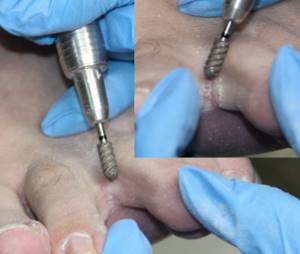
Hall equipment
The office of a nail technician who provides hardware pedicure services resembles a dentist’s office. The set for hardware pedicure includes vacuum cleaners, spray bottles, and UV cabinets with many tools and attachments. The cutters should be available in large quantities to make the procedure more painless, comfortable, safe and hygienic. The master’s office must be equipped with a specialized pedicure chair, on which the client can not only sit, but also lie comfortably during the entire procedure.
Disadvantages of hardware pedicure
There are very few disadvantages to this procedure, however, they do exist. Let's take a look at them.
- High price. In salons, this procedure is quite expensive, which turns off many clients. However, if you evaluate that the specialist, in addition to the equipment itself, uses antiseptics, keratolytic preparations and caring cosmetics, the cost of such treatment is completely justified.
- Slight discomfort. Persons with overly sensitive skin may experience slight discomfort during treatment, in particular, burning in the affected area.
Important! This technology is not suitable for people with very thin nail plates.
What questions should you ask the master?
If you came to the salon for the first time or have not tried a hardware pedicure before, then ask the specialist the following questions in advance.
- Does he have a certificate confirming his qualifications?
- Will the pedicure be performed entirely using the hardware method or is it actually a combined option?
- Does the technician have enough attachments to treat all your problem areas?
- How will you interact with the specialist if discomfort arises during the procedure?
- Is it possible to increase the price after the procedure? Can the master independently evaluate the work done and its cost?
- How long will the procedure take?
- How often should it be repeated in your case?
Technology for performing hardware pedicure at home
Many women, having become acquainted with hardware pedicure in a salon, decide to purchase equipment and treat their heels and nail plates themselves. True, here you need to understand that without knowing the basics you can harm yourself.
To carry out the procedure you will need:
• pedicure apparatus; • set of cutters and attachments; • nail clippers; • keratolic skin softening agents; • cuticle oil; • eye protection and face mask; • toe separator; • spray bottle with water; • paper towels; • antiseptics; • foot cream.
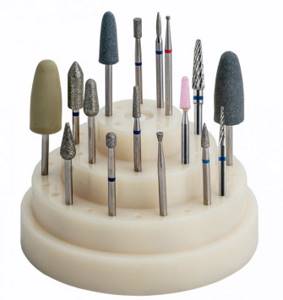
Below are step-by-step instructions for treating feet.
Important! Before starting a pedicure, your feet should be thoroughly washed and dried. You should not sand wet leather, because in this case you will not achieve the desired smoothness.
1. Sit so that you can comfortably care for your legs.
2. Apply antiseptics to your hands, feet, and nail beds to prevent infection.
3. If necessary, use tweezers to adjust the length of your nails.
4. Apply a keratolytic agent to the feet and heels that you are going to treat and let it soak in for 10-15 minutes.
5. Before starting work, put on a mask and safety glasses.
6. Remove any remaining emollient cream with a paper towel.
7. Select a suitable cutter and insert a coarse abrasive attachment for rough processing of the skin. The nozzle can be either reusable or disposable. However, practice shows that disposable attachments are more effective and allow you to achieve results much faster.
8. Using a spray bottle, spray the treated areas and wipe the foot with a paper towel.
9. Let's move on to processing the fingers. They should also be treated with an emollient cream. 10 minutes after applying the product, take a ceramic nozzle with a truncated cone and carefully treat the areas between your fingers. Rotation speed is 5-10 thousand revolutions.
Important! There are many sweat glands between the fingers, which means that rough skin in these areas will contribute to the spread of infection.
10. Install a nozzle with a finer grain (similar shape, pink or red), and repeat the process between your fingers, smoothing out any roughness.

11. Spray the skin with a spray bottle and then blot the treated areas with a paper towel.
12. Apply cuticle softening oil to the areas around your nails and let it soak in for 5 minutes.
13. Without changing the nozzle or rotation speed, carefully sand the periungual ridges, removing excess.
14. Change the nozzle to a diamond, ball-shaped one. This technology does not involve cutting or moving cuticles. In this case, the cuticle is simply polished with a suitable nozzle at a speed not exceeding 6 thousand revolutions.
15. After installing the felt tip, polish the nail plates until they shine.
16. All that remains is to lubricate the feet, heels, areas between the toes and around the nails with foot skin care cream, and rub it in with gentle stroking movements.
Professional device
If you are not a professional and are purchasing a machine only for personal home use, then home equipment will do; it will also come in handy when learning professional pedicure. Such a device has a small number of revolutions (from 1500 to 5000 per minute) and low power. It is very convenient for storage, has small dimensions and weight. When working, take breaks every 15 minutes to ensure your equipment lasts longer.
The professional unit differs in size, speed (from 30,000 rpm) and power. It has a built-in vacuum cleaner for collecting sawdust, a foot pedal, protection against overheating and accidental activation without tools.
How to choose a hardware pedicure specialist
It must be said that unprofessional treatment of feet and heels can do more harm than good. This is why many women hesitate to purchase a pedicure machine when going to a beauty salon. The only question that remains is how to choose a specialist so as not to regret the result. Here are some recommendations:
- Choose only proven salons that you have already visited yourself or heard about the professionalism of their masters from friends.
- If the salon is unfamiliar to you, be sure to look on the Internet and read reviews about the work of pedicurists.
- Do not rush to trust the masters who provide services at home. Among them there are many self-taught and non-professionals. In addition, craftsmen who offer services at low prices most likely use low-quality materials in their work.
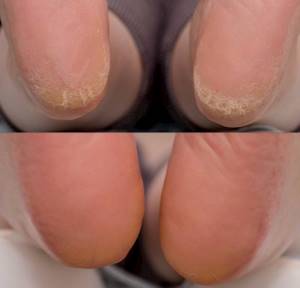
Once you try a hardware pedicure, you will be able to appreciate the benefits of a new approach to foot and heel care, and you will never give it up.
Health and beauty to your feet!
- Author: woman
Rate this article:
- 5
- 4
- 3
- 2
- 1
(7 votes, average: 5 out of 5)
Share with your friends!
Recommendations for Beginners
To give yourself a pedicure using an electric device at home, I would advise beginners to still adhere to certain rules:
- Start working at minimum speeds to get used to the machine or avoid injury if you are careless.
- Position the nozzle in relation to the plane of the body at approximately 35 degrees.
- When processing the nail fold, it is advisable to move the cutter in the direction of nail growth.
- The cuticle should be processed from the center to the edge.
- To prevent the attachment from jumping off, move it opposite to the rotation of the cutter.
- Do not press the nozzle tightly against the skin while the device is operating and do not hold it in one place for a long time.
That's probably all I wanted to tell you. Don't be afraid to start, it's not difficult. The main thing is that once you get the hang of it, you will no longer be fixated on the salon, since you can get your legs in order at any time convenient for you.
Happy pedicure! See you!







